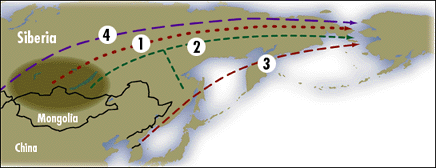

Arriving from the East
Fossils indicate that the people of the Americas have a very diverse ancestry. More than one migration most likely occurred over the Bering Land Bridge, and from more than one location. Dating the genetic components of the cell, such as y chromosomes and mtDNA, by genetic analysis consistently pushes back arrival dates when compared to the dates that have been determined from linguitic and archaeological artifacts. The following migrations suggested challenge the Clovis first theory, and support the existence and arrival of Pre-Clovis cultures.
Genetic Evidence
A recent study using mtDNA analysis of Native American populations (Theodore G. Schurr, 2000), indicates that there may have been five lineages (A,B,C,D,X) taking four routes arriving to Alaska via the Bering Land Bridge during two major migrations. An early migration may have occurred between 20,000 and 40,000 ya, and a later migration occurred after the last glacial maximum which was 18,000 ya. Each lineage arrived before the last glacial maximum, so more than one migration occurred by the same people.
Have a look at the map above. The first route (A-D,?X) came from Southeast Siberia. The second (A-D) came from Baikal and Amure River regions. The third (B) came from East Asia, and the fourth route (X) came from Eurasia.
There has been a lot of interest in the X lineage because our ancesters may have been European. Low frequencies of this lineage have been found in European, Middle Eastern, and West Asian groups primarily in North America.
A mutation in the haplogroup (lineage) A was isolated at some point, and diverged genetically. This mutation was discovered in the Koryaks, Chukchi, Eskimos of Siberia and the northwestern tip of North America, and the Na-Déné Indians which includes the Navajo of the Southwest.
Genetic, Archaeological, and Linguistic Evidence
A previous compilation of genetic, archeological, and linguistic evidence indicates that three different cultures of Native Americans arrived via the Bering Land Bridge (Elias, 1995). The first wave indicates the Ameridians, the second refers to the Na-Déné, and the third migration refers to the more recent Neut-Inuit arrival.

